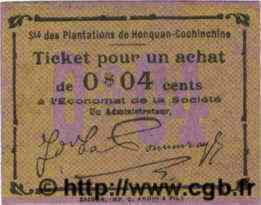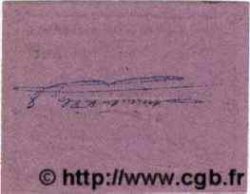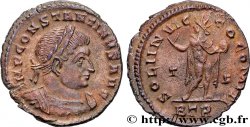b26_0351 - 4 Cents avec signature au revers FRENCH INDOCHINA 1920
недоступный.
Товар уже продан в нашем интернет-магазине
Цена: : 365.88 €
Товар уже продан в нашем интернет-магазине
Цена: : 365.88 €
Номинальная стоимость: 4 Cents avec signature au revers
Дата: (1920)
Период/Провинции/Банки Société des Plantations de Honquan, Cochinchine
Дополнительные ссылки: KM.214 var
Комментарий
Émission de nécessité de cette plantation, uniface, imprimé en noir sur fond jaune, carton violet avec une signature manuscrite indéchiffrable au dos. Il s'agit peut-être d'une deuxième série. Nous ne connaissons que ce billet et un 20 cents avec signature au dos. Ces "billets de nécessité" avaient une double fonction : éviter de devoir alimenter l'économat de la Société avec de la monnaie mais surtout concentrer les revenus des travailleurs journaliers sur les boutiques et services proposés dans la plantation, par l'employeur-propriétaire. Cette technique, mieux connue en Amérique du Sud, permet en pratique de récupérer le salaire versé en échange des moyens de substistance des employés. Il les empêche aussi de quitter la plantation puisqu'il rend difficile la constitution de réserves et d'économies en monnaie nationale.
Emergency issue from this plantation, single-sided, printed in black on a yellow background, purple cardboard with an indecipherable handwritten signature on the back. This may be a second series. We only know of this note and a 20-cent note with a signature on the back. These \\\"emergency notes\\\" had a dual function: to avoid having to supply the Company's commissary with banknote but above all to concentrate the income of day laborers on the shops and services offered on the plantation by the employer-owner. This technique, better known in South America, allows in practice to recover the wages paid in exchange for the employees' means of subsistence. It also prevents them from leaving the plantation since it makes it difficult to build up reserves and savings in national banknote
Emergency issue from this plantation, single-sided, printed in black on a yellow background, purple cardboard with an indecipherable handwritten signature on the back. This may be a second series. We only know of this note and a 20-cent note with a signature on the back. These \\\"emergency notes\\\" had a dual function: to avoid having to supply the Company's commissary with banknote but above all to concentrate the income of day laborers on the shops and services offered on the plantation by the employer-owner. This technique, better known in South America, allows in practice to recover the wages paid in exchange for the employees' means of subsistence. It also prevents them from leaving the plantation since it makes it difficult to build up reserves and savings in national banknote










 Cообщить об ошибке
Cообщить об ошибке Распечатать страницу
Распечатать страницу Отправить мой выбор
Отправить мой выбор Задать вопрос
Задать вопрос Consign / sell
Consign / sell
 Информация
Информация













